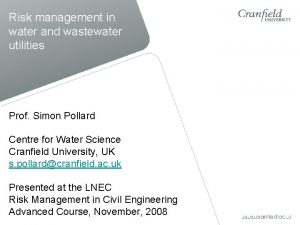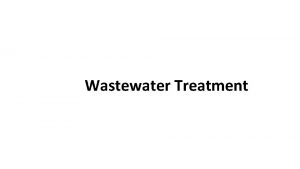Water Pollution Water Pollution Wastewater water that goes





- Slides: 5

Water Pollution

Water Pollution Wastewater: water that goes down the drain and flows through pipes to a wastewater treatment plant Wastewater Treatment Plant: location where wastewater is treated before being returned to a lake or river. - Unfortunately these treatment plants may not remove all of the harmful substances in water Sludge: the solid material remaining after wastewater has gone through the treatment process, containing dangerous concentrations of toxic chemicals (hazardous waste) - has to be disposed of via incineration and burial (expensive)

Water Pollution Pathogens: disease-causing organisms, such as bacteria, viruses and parasitic worms entering water supplies through untreated wastewater and animal feces. E. g. Cholera, hepatitis, and typhoid (diseases people can catch by drinking water polluted with pathogens) Artificial Eutrophication: an abundance of nutrients caused by excess Phosphorus (from detergents, animal wastes and fertilizers) which causes accelerated growth of algae. When the algae die and decompose it uses up much of the oxygen in the water and “chokes” remaining organisms in the water.

Water Pollution Thermal Pollution: when excessive amounts of heat are added to a body of water from the cooling systems of power plants and other industries located along lakes or rivers. - this kills fish when temperatures are too warm for them to tolerate (also warmer water cannot hold as much oxygen) Groundwater Pollution: pollution like pesticides, chemical fertilizers, road salts, engine oil etc. that seeps through the ground into the water supply stored underground. - It is difficult to clean groundwater because some of the pollutants have dispersed through the soil, and stuck to the sand rock

Questions: 1. Why is point pollution easier to eliminate than nonpoint pollution? 2. How do pathogens pollute the water, and how might these affect humans? 3. Why is groundwater so difficult to clean up? 4. How does fertilizer end up killing fish?









